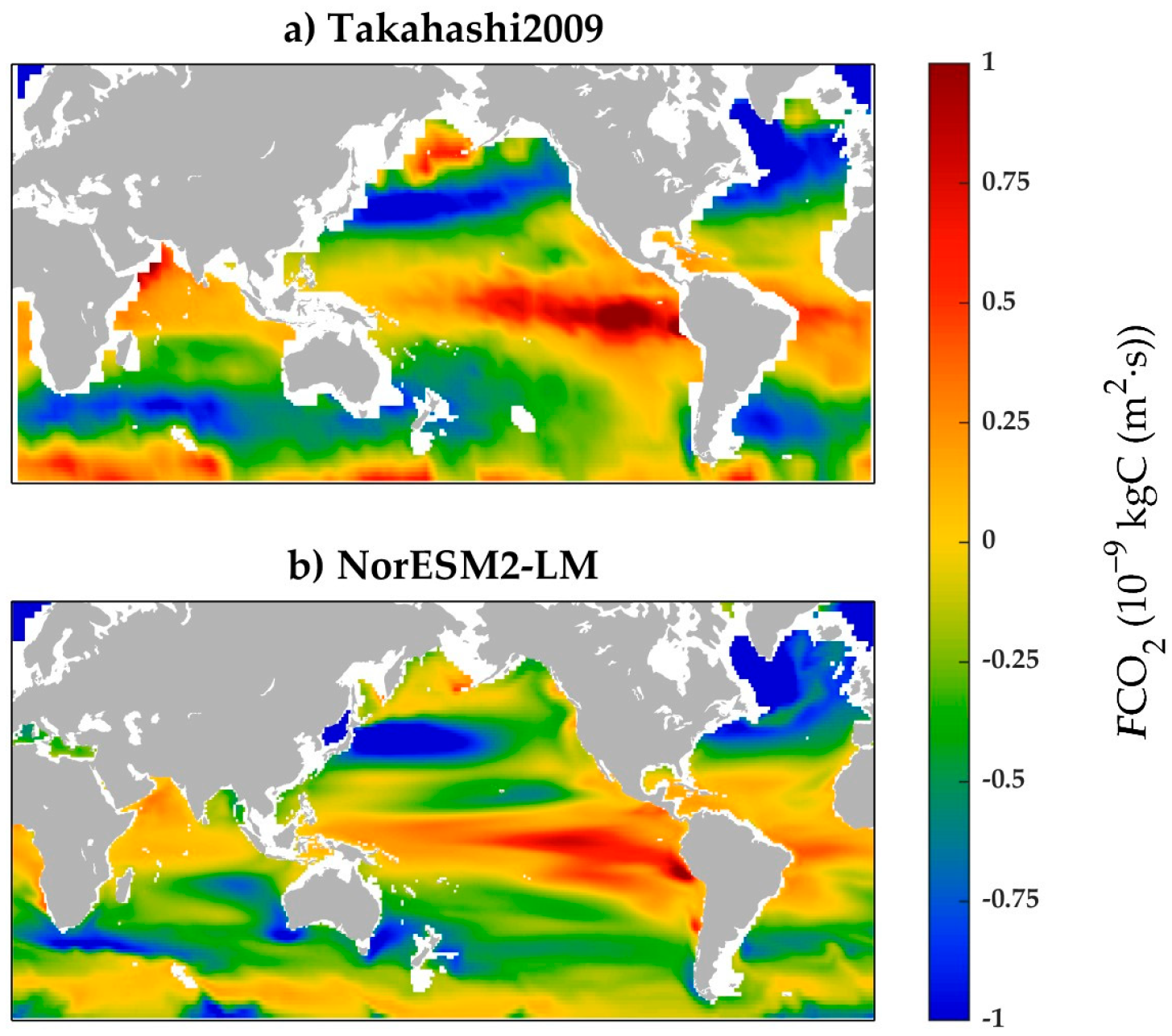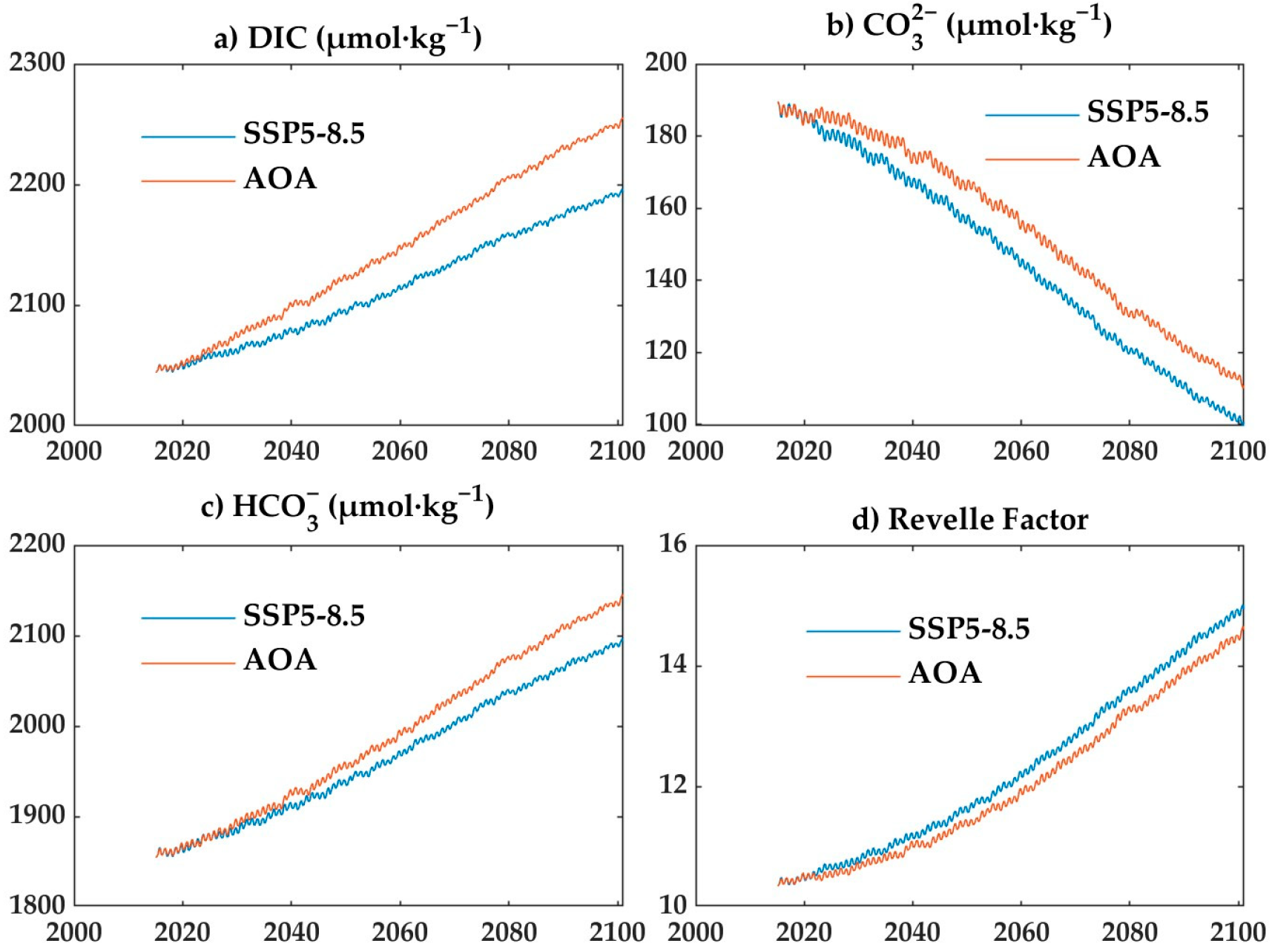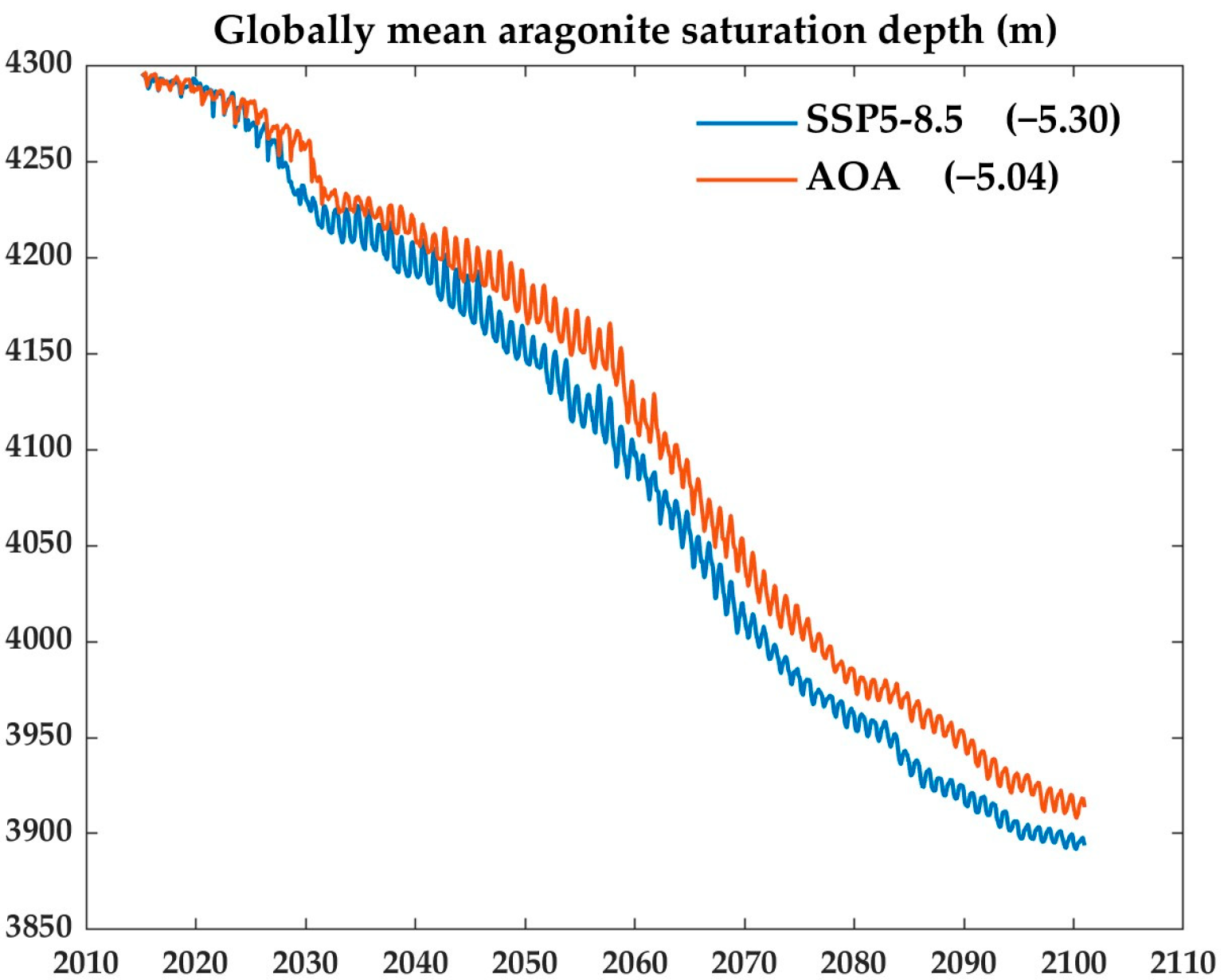Future Changes in Carbon Chemistry Under the Implementation of Artificial Ocean Alkalinization Based on CMIP6 Simulations
Abstract
1. Introduction
2. Materials and Methods
3. Results and Discussion
3.1. Performance of the Model Simulation
3.2. Variations of the Marine Carbon System During AOA
3.3. Effect of AOA on Air–Sea CO2 Exchange Flux
3.4. Effects of AOA on the Ocean Interior, Take Ω for an Example
4. Conclusions
Author Contributions
Funding
Institutional Review Board Statement
Informed Consent Statement
Data Availability Statement
Acknowledgments
Conflicts of Interest
Appendix A
Appendix B
References
- Core Writing Team. Climate Change 2023: Synthesis Report. In Contribution of Working Groups I, II and III to the Sixth Assessment Report of the Intergovernmental Panel on Climate Change; Lee, H., Romero, J., Eds.; IPCC: Geneva, Switzeland, 2023; p. 4. [Google Scholar]
- Friedlingstein, P.; O’Sullivan, M.; Jones, M.W.; Andrew, R.M.; Bakker, D.C.E.; Hauck, J.; Landschützer, P.; Le Quéré, C.; Luijkx, I.T.; Peters, G.P.; et al. Global Carbon Budget 2023. Earth Sys. Sci. Data 2023, 15, 5301–5369. [Google Scholar] [CrossRef]
- Gruber, N.; Bakker, D.C.E.; DeVries, T.; Gregor, L.; Hauck, J.; Landschützer, P.; McKinley, G.A.; Müller, J.D. Trends and variability in the ocean carbon sink. Nat. Rev. Earth Environ. 2023, 4, 119–134. [Google Scholar] [CrossRef]
- Ciais, P.; Sabine, C.; Bala, G.; Bopp, L.; Brovkin, V.; Canadell, J.; Chhabra, A.; DeFries, R.; Galloway, J.; Heimann, M.; et al. Carbon and Other Biogeochemical Cycles. In Climate Change 2013: The Physical Science Basis. Contribution of Working Group I to the Fifth Assessment Report of the Intergovernmental Panel on Climate Change; Stocker, T.F., Qin, Q., Plattner, G.-K., Tignor, M., Allen, S.K., Boschung, J., Nauels, A., Xia, Y., Bex, V., Midgley, P.M., Eds.; Cambridge University Press: Cambridge, UK, 2014; p. 472. [Google Scholar]
- Zeebe, R.E. History of Seawater Carbonate Chemistry, Atmospheric CO2, and Ocean Acidification. Ann. Rev. Earth Planet Sci. 2012, 40, 141–165. [Google Scholar] [CrossRef]
- Wolf-Gladrow, D.A.; Zeebe, R.E.; Klaas, C.; Körtzinger, A.; Dickson, A.G. Total alkalinity: The explicit conservative expression and its application to biogeochemical processes. Mar. Chem. 2007, 106, 287–300. [Google Scholar] [CrossRef]
- Köhler, P.; Abrams, J.F.; Völker, C.; Hauck, J.; Wolf-Gladrow, D.A. Geoengineering impact of open ocean dissolution of olivine on atmospheric CO2, surface ocean pH and marine biology. Environ. Res. Lett. 2013, 8, 14009. [Google Scholar] [CrossRef]
- Renforth, P.; Henderson, G. Assessing ocean alkalinity for carbon sequestration. Rev. Geophys. 2017, 55, 636–674. [Google Scholar] [CrossRef]
- Feng, E.Y.; Koeve, W.; Keller, D.P.; Oschlies, A. Model-Based Assessment of the CO2 Sequestration Potential of Coastal Ocean Alkalinization. Earth’s Future 2017, 5, 1252–1266. [Google Scholar] [CrossRef]
- Ilyina, T.; Wolf-Gladrow, D.; Munhoven, G.; Heinze, C. Assessing the potential of calcium-based artificial ocean alkalinization to mitigate rising atmospheric CO2 and ocean acidification. Geophys. Res. Lett. 2013, 40, 5909–5914. [Google Scholar] [CrossRef]
- Feng, E.Y.; Keller, D.P.; Koeve, W.; Oschlies, A. Could artificial ocean alkalinization protect tropical coral ecosystems from ocean acidification? Environ. Res. Lett. 2016, 11, 74008. [Google Scholar] [CrossRef]
- Keller, D.P.; Feng, E.Y.; Oschlies, A. Potential climate engineering effectiveness and side effects during a high carbon dioxide-emission scenario. Nat. Comm. 2014, 5, 3304. [Google Scholar] [CrossRef]
- Zhou, M.; Tyka, M.D.; Ho, D.T.; Yankovsky, E.; Bachman, S.; Nicholas, T.; Karspeck, A.R.; Long, M.C. Mapping the global variation in the efficiency of ocean alkalinity enhancement for carbon dioxide removal. Nat. Clim. Change 2024, 15, 59–65. [Google Scholar] [CrossRef]
- Tollefson, J. Start-ups are adding antacids to the ocean to slow global warming. Will it work? Nature 2023, 618, 902–904. [Google Scholar] [CrossRef]
- Xin, X.; Goldenberg, S.U.; Taucher, J.; Stuhr, A.; Arístegui, J.; Riebesell, U. Resilience of Phytoplankton and Microzooplankton Communities under Ocean Alkalinity Enhancement in the Oligotrophic Ocean. Environ. Sci. Technol 2024, 58, 20918–20930. [Google Scholar] [CrossRef]
- Cai, W.-J.; Jiao, N. Wastewater alkalinity addition as a novel approach for ocean negative carbon emissions. Innovation 2022, 3, 100272. [Google Scholar] [CrossRef]
- González, M.F.; Ilyina, T.; Sonntag, S.; Schmidt, H. Enhanced Rates of Regional Warming and Ocean Acidification After Termination of Large-Scale Ocean Alkalinization. Geophys. Res. Lett. 2018, 45, 7120–7129. [Google Scholar] [CrossRef]
- Burt, D.J.; Fröb, F.; Ilyina, T. The Sensitivity of the Marine Carbonate System to Regional Ocean Alkalinity Enhancement. Front. Clim. 2021, 3, 624075. [Google Scholar] [CrossRef]
- Bach, L.T.; Ferderer, A.J.; LaRoche, J.; Schulz, K.G. Technical note: Ocean Alkalinity Enhancement Pelagic Impact Intercomparison Project (OAEPIIP). Biogeosciences 2024, 21, 3665–3676. [Google Scholar] [CrossRef]
- Seland, Ø.; Bentsen, M.; Olivié, D.; Toniazzo, T.; Gjermundsen, A.; Graff, L.S.; Debernard, J.B.; Gupta, A.K.; He, Y.-C.; Kirkevåg, A.; et al. Overview of the Norwegian Earth System Model (NorESM2) and key climate response of CMIP6 DECK, historical, and scenario simulations. Geosci. Model Dev. 2020, 13, 6165–6200. [Google Scholar] [CrossRef]
- Tjiputra, J.F.; Roelandt, C.; Bentsen, M.; Lawrence, D.M.; Lorentzen, T.; Schwinger, J.; Seland, Ø.; Heinze, C. Evaluation of the carbon cycle components in the Norwegian Earth System Model (NorESM). Geosci. Model Dev. 2020, 6, 301–325. [Google Scholar] [CrossRef]
- Hunke, E.C.; Lipscomb, W.H.; Turner, A.K.; Jeffery, N.; Elliott, S. CICE: The Los Alamos Sea Ice Model; Documentation and Software User’s Manual, Version 5.1; Tech. Rep. LA-CC-06-012; T-3 Fluid Dynamics Group, Los Alamos National Laboratory: Los Alamos, NM, USA, 2015. [Google Scholar]
- Lawrence, D.M.; Fisher, R.A.; Koven, C.D.; Oleson, K.W.; Swenson, S.C.; Bonan, G.; Collier, N.; Ghimire, B.; Kampenhout, L.; van Kennedy, D.; et al. The Community Land Model Version 5: Description of New Features, Benchmarking, and Impact of Forcing Uncertainty. J. Adv. Model. Earth Syst. 2019, 11, 4245–4287. [Google Scholar] [CrossRef]
- Eyring, V.; Bony, S.; Meehl, G.A.; Senior, C.A.; Stevens, B.; Stouffer, R.J.; Taylor, K.E. Overview of the Coupled Model Intercomparison Project Phase 6 (CMIP6) experimental design and organization. Geosci. Model Dev. 2016, 9, 1937–1958. [Google Scholar] [CrossRef]
- Keller, D.P.; Lenton, A.; Scott, V.; Vaughan, N.E.; Bauer, N.; Ji, D.; Jones, C.D.; Kravitz, B.; Muri, H.; Zickfeld, K. The Carbon Dioxide Removal Model Intercomparison Project (CDRMIP): Rationale and experimental protocol for CMIP6. Geosci. Model Dev. 2018, 11, 1133–1160. [Google Scholar] [CrossRef]
- Takahashi, T.; Sutherland, S.C.; Wanninkhof, R.; Sweeney, C.; Feely, R.A.; Chipman, D.W.; Hales, B.; Friederich, G.; Chavez, F.; Sabine, C.; et al. Climatological mean and decadal change in surface ocean pCO2, and net sea–air CO2 flux over the global oceans. Deep Sea Res. Top. Stud. Oceanogr. 2009, 56, 554–577. [Google Scholar] [CrossRef]
- Takahashi, T.; Sutherland, S.C.; Sweeney, C.; Poisson, A.; Metzl, N.; Tilbrook, B.; Bates, N.; Wanninkhof, R.; Feely, R.A.; Sabine, C.; et al. Global sea-air CO2 flux based on climatological surface ocean pCO2, and seasonal biological and temperature effects. Deep Sea Res. Top. Stud. Oceanogr. 2002, 49, 1601–1622. [Google Scholar] [CrossRef]
- Qu, B.; Song, J.; Li, X.; Yuan, H.; Zhang, K.; Xu, S. Global air-sea CO2 exchange flux since 1980s: Results from CMIP6 Earth System Models. J. Ocean. Limnol. 2022, 40, 1417–1436. [Google Scholar] [CrossRef]
- Meinshausen, M.; Nicholls, Z.R.J.; Lewis, J.; Gidden, M.J.; Vogel, E.; Freund, M.; Beyerle, U.; Gessner, C.; Nauels, A.; Bauer, N.; et al. The shared socio-economic pathway (SSP) greenhouse gas concentrations and their extensions to 2500. Geosci. Model Dev. 2020, 13, 3571–3605. [Google Scholar] [CrossRef]
- Egleston, E.S.; Sabine, C.L.; Morel, F.M.M. Revelle revisited: Buffer factors that quantify the response of ocean chemistry to changes in DIC and alkalinity. Glob. Biogeochem. Cycles 2010, 24, GB1002. [Google Scholar] [CrossRef]
- Zeebe, R.E.; Wolf-Gladrow, D. CO2 in Seawater: Equilibrium, Kinetics, Isotopes; Elsevier Oceanography Series 65; Elsevier: Amsterdam, The Netherlands, 2001; pp. 1–360. [Google Scholar]







| CMIP6 Experiment ID | Simulation Description | Run Time |
|---|---|---|
| esm-his | CO2-emission-driven historical scenario | 1850–2014 |
| esm-ssp585 | CO2-emission-driven SSP5-8.5 scenario | 2015–2100 |
| esm-ssp585-ocn-alk | SSP5-8.5 scenario with 0.14 Pmol yr−1 alkalinity added | 2015–2100 |
Disclaimer/Publisher’s Note: The statements, opinions and data contained in all publications are solely those of the individual author(s) and contributor(s) and not of MDPI and/or the editor(s). MDPI and/or the editor(s) disclaim responsibility for any injury to people or property resulting from any ideas, methods, instructions or products referred to in the content. |
© 2025 by the authors. Licensee MDPI, Basel, Switzerland. This article is an open access article distributed under the terms and conditions of the Creative Commons Attribution (CC BY) license (https://creativecommons.org/licenses/by/4.0/).
Share and Cite
Qu, B.; Song, J.; Li, X.; Yuan, H.; Duan, L. Future Changes in Carbon Chemistry Under the Implementation of Artificial Ocean Alkalinization Based on CMIP6 Simulations. Oceans 2025, 6, 29. https://doi.org/10.3390/oceans6020029
Qu B, Song J, Li X, Yuan H, Duan L. Future Changes in Carbon Chemistry Under the Implementation of Artificial Ocean Alkalinization Based on CMIP6 Simulations. Oceans. 2025; 6(2):29. https://doi.org/10.3390/oceans6020029
Chicago/Turabian StyleQu, Baoxiao, Jinming Song, Xuegang Li, Huamao Yuan, and Liqin Duan. 2025. "Future Changes in Carbon Chemistry Under the Implementation of Artificial Ocean Alkalinization Based on CMIP6 Simulations" Oceans 6, no. 2: 29. https://doi.org/10.3390/oceans6020029
APA StyleQu, B., Song, J., Li, X., Yuan, H., & Duan, L. (2025). Future Changes in Carbon Chemistry Under the Implementation of Artificial Ocean Alkalinization Based on CMIP6 Simulations. Oceans, 6(2), 29. https://doi.org/10.3390/oceans6020029





